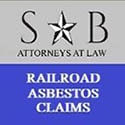
What Is Asbestos?
Asbestos is the name given to six minerals that occur naturally in the environment as bundles of fibers that can be separated into thin, durable threads for use in commercial and industrial applications. These fibers are resistant to heat, fire, and chemicals and do not conduct electricity. For these reasons, asbestos has been used widely in many industries. Additional asbestos-like minerals are found in the natural environment, including erionite.
Chemically, asbestos minerals are silicate compounds, meaning they contain atoms of silicon and oxygen in their molecular structure.
Asbestos minerals are divided into two major groups: Serpentine asbestos and amphibole asbestos. Serpentine asbestos includes the mineral chrysotile, which has long, curly fibers that can be woven. Chrysotile asbestos is the form that has been used most widely in commercial applications. Amphibole asbestos includes the minerals actinolite, tremolite, anthophyllite, crocidolite, and amosite. Amphibole asbestos has straight, needle-like fibers that are more brittle than those of serpentine asbestos and are more limited in its ability to be fabricated.
What Factors Affect the Risk of Developing an Asbestos-related Disease?
Several factors can help to determine how asbestos exposure affects an individual, including:
- Dose (how much asbestos an individual was exposed to)
- Duration (how long an individual was exposed)
- Size, shape, and chemical makeup of the asbestos fibers
- Source of the exposure
- Individual risk factors, such as smoking and pre-existing lung disease
- Genetic factors, such as having a germline mutation in BAP1
Although all forms of asbestos are considered hazardous, different types of asbestos fibers may be associated with different health risks. For example, the results of several studies suggest that amphibole forms of asbestos may be more harmful than chrysotile, particularly for mesothelioma risk, because they tend to stay in the lungs for a longer period of time.
How Are Asbestos-related Diseases Detected?
Individuals who have been exposed (or suspect they have been exposed) to asbestos fibers on the job, through the environment, or at home via a family contact should inform their doctor about their exposure history and whether or not they experience any symptoms. The symptoms of asbestos-related diseases may not become apparent for many decades after the exposure. It is particularly important to check with a doctor if any of the following symptoms develop:
- Shortness of breath, wheezing, or hoarseness
- A persistent cough that gets worse over time
- Blood in the sputum (fluid) coughed up from the lungs
- Pain or tightening in the chest
- Difficulty swallowing
- Swelling of the neck or face
- Loss of appetite
- Weight loss
- Fatigue or anemia
A thorough physical examination, including a chest x-ray and lung function tests, may be recommended. The chest x-ray is currently the most common tool used to detect asbestos-related diseases. Although chest x-rays cannot detect asbestos fibers in the lungs, they can help identify any early signs of lung disease resulting from asbestos exposure.
A lung biopsy, which detects microscopic asbestos fibers in pieces of lung tissue removed by surgery, is the most reliable test to confirm exposure to asbestos. A bronchoscopy is a less invasive test than a biopsy and detects asbestos fibers in material that is rinsed out of the lungs. It is important to note that these procedures cannot determine how much asbestos an individual may have been exposed to or whether disease will develop. Asbestos fibers can also be detected in urine, mucus, and feces, but these tests are not reliable for determining how much asbestos may be in an individual’s lungs.
What Is An Asbestos Trust Fund Claim?
Asbestos was a toxic material that was not properly regulated by manufacturers. This lack of regulation lead to dangerous exposure for thousands of workers and individuals. Due to the reckless decisions of asbestos manufacturing companies, over 30 billion dollars has been set aside in trusts to help those who have been impacted by their time working around this harmful material. There are multiple asbestos trusts paying out individuals like you for the time they spent working around asbestos.
Our legal team works with you to gather the documentation you need to apply to these different trusts. Whether you have mesothelioma, experience chronic shortness of breath, or have developed asbestos-related cancer, you may qualify for compensation. Let us help you get the money you deserve for your time spent working around asbestos when you file an asbestos trust fund claim today.
Do I Have To Go to Court or Give a Deposition if I File Asbestos Trust Claims?
No, these claims are filed outside the traditional court system. You do not have to go to court or give any depositions. After the claims are filed, all you must do is sign release documents and receive your check-in mail.
Can I File An Asbestos Claim?
If you have a history of significant asbestos exposure you may qualify for financial compensation. Individuals who worked closely with asbestos and have since developed related health conditions, including shortness of breath, are able to file for an asbestos trust fund claim. There are multiple different trusts paying out individuals for their pain and suffering. Our team will work with you to navigate the process and apply to all the trusts that fit your specific background and state of health.
If you worked with asbestos before 1982 and have developed any health problems, you may qualify for compensation. Some asbestos-related diseases can take up to 30 years to develop after exposure and may not affect the respiratory system. Contact our asbestos law firm today to learn more about your options after being exposed to asbestos at your workplace.
Free Asbestos Exposure Consultation
At Sammons & Berry, P.C. we offer a no-cost, no-obligation consultation, so you can discuss the facts of your case without paying for anything upfront. Asbestos trusts claims do not require a lawsuit, depositions or courtrooms. The process is simple and easy for the client and should not require any stressful legal confrontations for the client. The law firm handles all of the claims for the client, helping you maximize your compensation. We do not accept any payments from our clients until they receive compensation. We charge on a contingent fee basis, which means you pay a percentage of what you get paid in your claim. If we are unable to collect anything for you, there is no cost to you.
Call (800) 519-1440 to speak with a Sammons and Berry, P.C. representative and start your journey towards compensation.
Wrongful Death Claims For Families of Asbestos Victims
If you have lost a loved one due to the harmful exposure of asbestos, you may be entitled to compensation. If you can provide a work history and a death certificate for your loved one, our attorneys can help you file an asbestos claim. We understand how difficult this process can be, this is why we work with you every step of the way to help you get the money you deserve. Reach out to our team today to learn more about filing a claim for a family member.
See if you qualify for compensation
Sammons & Berry, P.C .
720 W Main St,
Tomball, TX 77375
800-519-1440
Google Listing
Facebook


